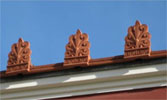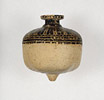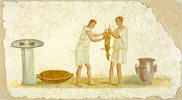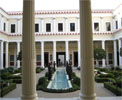


Each unit below includes pre-visit activities for use in your classroom, as well as activities for use in the galleries at the Getty Villa. Post-visit follow-up activities are also suggested for each gallery activity.
|
 |

|
 |
 |
Activities 1–10 of 10 |
 |
 |
 |
 |
 |

  |
 |
Architectural Elements of an Ancient Roman Villa
Grades/Level: Lower Elementary (K–2), Upper Elementary (3–5)
Subjects: Visual Arts, English—Language Arts, History—Social Science, Science
Activity Overview: Use this activity for a visit to the Getty Villa's grounds and gardens, and Galleries 201C and 207. Students learn about architectural details in an ancient Roman villa and look for these features throughout the Getty Villa's grounds, gardens, and galleries.
|
 |
 |
 |
Plant Myths
Grades/Level: Upper Elementary (3–5), Middle School (6–8)
Subjects: Visual Arts, English—Language Arts, History—Social Science, Science
Activity Overview: Use this activity for visiting the Getty Villa's Herb Garden and the Wine in Antiquity gallery (Gallery 213). Students find and identify plants in the Getty Villa's gardens and depicted on artwork inside the Museum and learn how these plants were incorporated into myths and everyday life in antiquity.
|
 |
 |
 |
Living Spaces in an Ancient Roman Villa
Grades/Level: Upper Elementary (3–5), Middle School (6–8)
Subjects: Visual Arts, English—Language Arts, History—Social Science, Science
Activity Overview: Use this activity for exploring the Getty Villa's Atrium and Triclinium, the Gods and Goddesses gallery (Gallery 104) and the Women and Children in Antiquity gallery (Gallery 207). Students learn the living spaces in an ancient Villa, describe their ancient use, and compare them to modern living spaces.
|
 |
 |
 |
The Cooking Class
Grades/Level: Upper Elementary (3–5), Middle School (6–8)
Subjects: Visual Arts, English—Language Arts, History—Social Science, Science
Activity Overview: Use this activity for exploring the Getty Villa's Herb Garden and the Men in Antiquity gallery (Gallery 209). Students identify herbs in the Herb Garden for an ancient recipe, and learn about ancient food preparation and eating practice.
|
 |
 |
 |
Form and Function in Ancient Architecture
Grades/Level: High School (9–12)
Subjects: Visual Arts, English—Language Arts, History—Social Science, Science, Mathematics
Activity Overview: Use this activity for visiting the Getty Villa's grounds and gardens, and the Arts of Greco-Roman Egypt gallery (Gallery 206). Students use Vitruvius's architectural principles to investigate details in the Getty Villa's architecture and in architecture depicted in works of art in the galleries.
|
 |
 |
 |
Garden Sculpture
Grades/Level: High School (9–12)
Subjects: Visual Arts, English—Language Arts, History—Social Science, Science
Activity Overview: Use this activity for visiting the Getty Villa's grounds and gardens. Students explore the Villa gardens, looking closely at the garden sculpture and reflecting on its meaning and use.
|
 |
 |
 |
Perfect Bodies, Ancient Ideals—A Set of Three Activities
Grades/Level: Middle School (6–8), High School (9–12)
Subjects: Visual Arts, English—Language Arts, History—Social Science
Activity Overview: Students investigate different examples of the human form in ancient art, focusing on three main concepts: the canon of proportions, the contrapposto pose, and idealized vs. realistic representations.
|
 |
 |
 |
People and Stories in Greek and Roman Art—A Set of 6 Activities
Grades/Level: Upper Elementary (3–5), Middle School (6–8)
Subjects: Visual Arts, English—Language Arts
Activity Overview: Take your students into the world of Greek and Roman stories at the J. Paul Getty Museum at the Getty Villa. Six self-guide activities introduce students to these ancient tales about heroes, monsters, gods, goddesses, athletes, and aristocrats through writing and drawing activities.
|
 |
 |
 |
My Getty Villa Travel Log—A Set of 6 Self-Guided Activities
Grades/Level: Lower Elementary (K–2), Upper Elementary (3–5)
Subjects: Visual Arts, English—Language Arts, History—Social Science
Activity Overview: Take your students on a journey into the ancient world at the J. Paul Getty Museum at the Getty Villa. Six activities allow students to travel through time, meet a variety of people, and take home a souvenir. They will practice writing about, observing, and drawing works of ancient art.
|
 |
 |
 |
Create Your Own Gallery Lesson for the Getty Villa
Grades/Level: Lower Elementary (K–2), Upper Elementary (3–5), Middle School (6–8), High School (9–12)
Subjects: Visual Arts, English—Language Arts, History—Social Science, Science, Mathematics
Activity Overview: You can create your own lesson for your visit to the Getty Villa. Use the collection of ancient art at the Getty Villa to teach subjects you are already covering in your classroom. Below are some tips on teaching in the Museum and engaging your students with art objects.
|
 |
![]() |
 |
 |
 |
 |
Activities 1–10 of 10 |
 |
 |
 |
 |
 |

  |
 |








